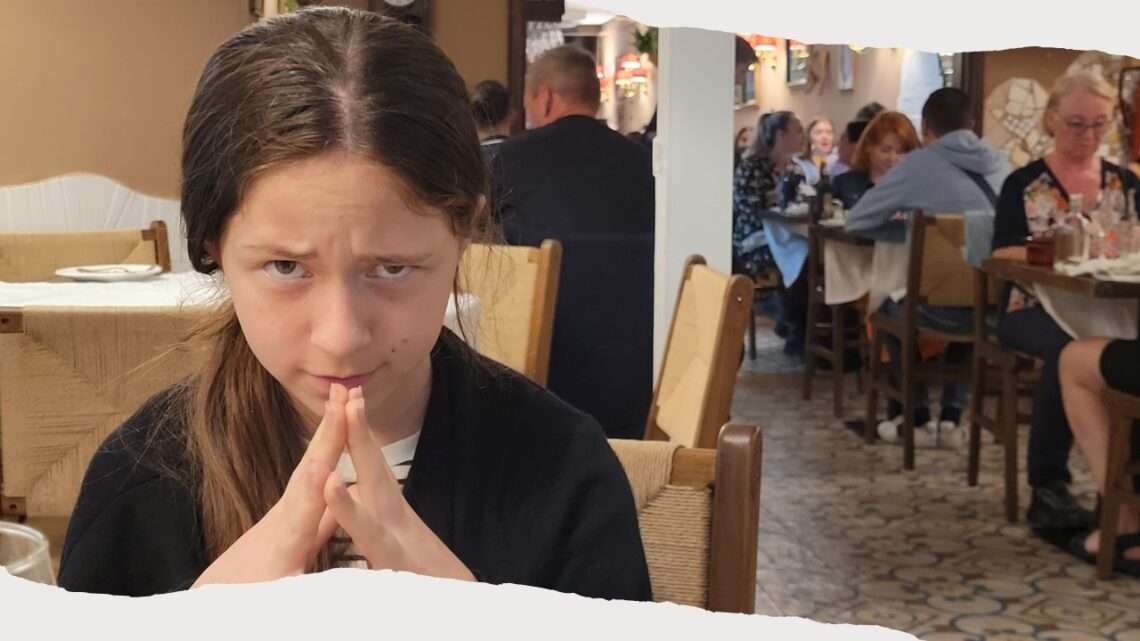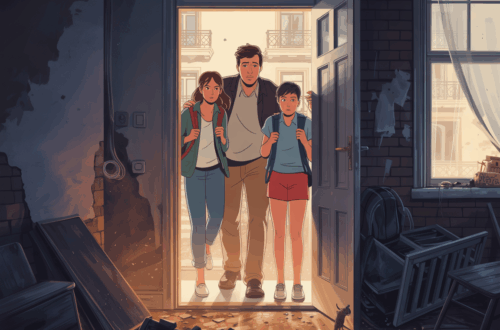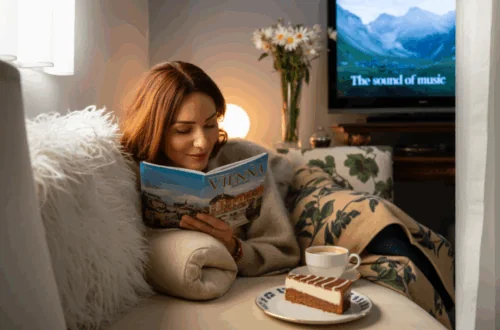Spain has been tough on us. The last time we visited, I got bit by a horse. This time, Gary fell ill with a really bad case of food poisoning. Unfortunately, the experience ruined the trip for him and impacted most of our itinerary. While the rest of us still had a great time, we had to take each day day-by-day, as we didn’t know what we were dealing with and we didn’t know exactly how to deal with it either. Some adventures you just don’t plan for. This is one of those.
The Valencian suspects
We learned on an earlier trip to Spain that we weren’t huge fans of traditional Spanish food. So for this trip, I decided to research restaurants with more modern takes on Spanish dishes, including fresher and lighter ingredients. In most cases, I had selected restaurants with high ratings and very enticing menus. Other finds we simply stumbled upon. Overall, we had some great food this trip. Nothing stood out in the moment as suspect of carrying food poisoning. So whatever the culprit, it was hiding in plain sight. It was incognito. We just know the culprit was likely something Gary ate 24-48 hours before he fell ill. Only he got sick.
Weeks later, he did recount that on the airplane, his chicken was still partially frozen, but he had decided to eat it anyways because he assumed it was precooked. This meal was 72 hours before he got sick. He also said the teriyaki chicken in Valencia, was less cooked the farther into the chicken breast he got, having a strange texture at the thickest part. But he ate it anyways and this meal was about 36 hours before he fell ill. He also wondered about a boiled egg on his avocado toast; something about it struck him odd but he couldn’t really put a finger on it. This meal was about 12 hours before he fell ill. His lunch, the last meal before he fell ill, consisted of a steak and a Caesar salad with chicken. Other people also ordered the same salad and did not get ill. So we think it was the teriyaki chicken. But, we really can’t be certain. All the dishes presented so nicely.
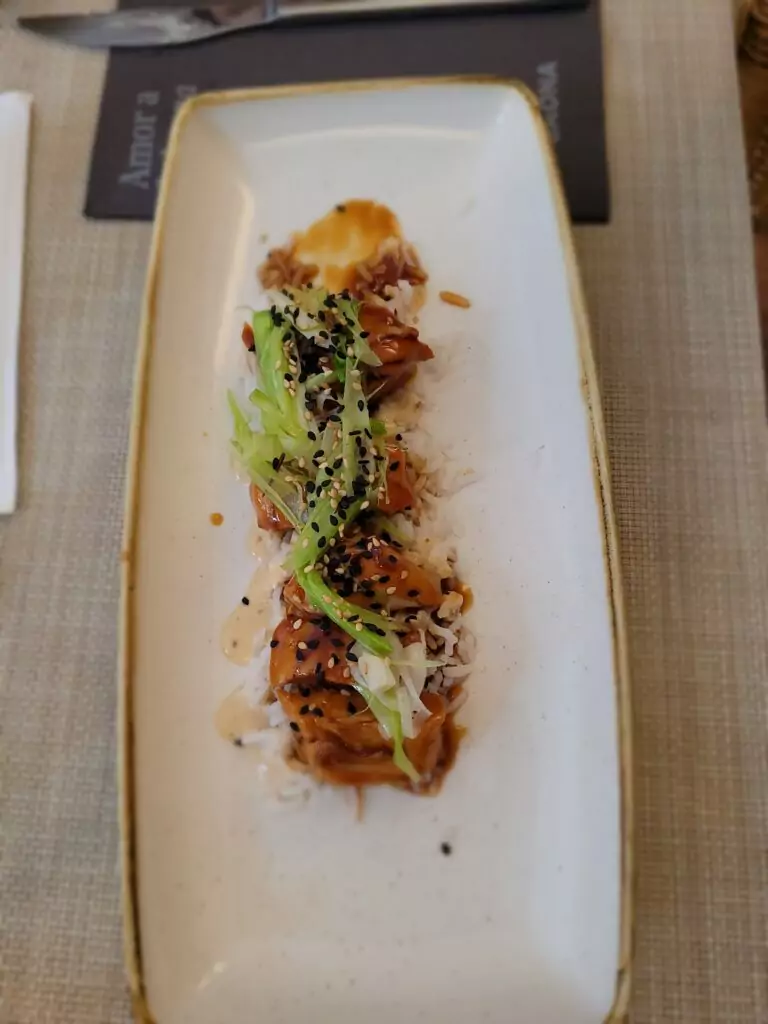
Suspect No. 1: Teriyaki chicken at Saona in Valencia. We ordered two of these dishes and Gary ate his and most of the second one. It seemed undercooked, but not completely raw.
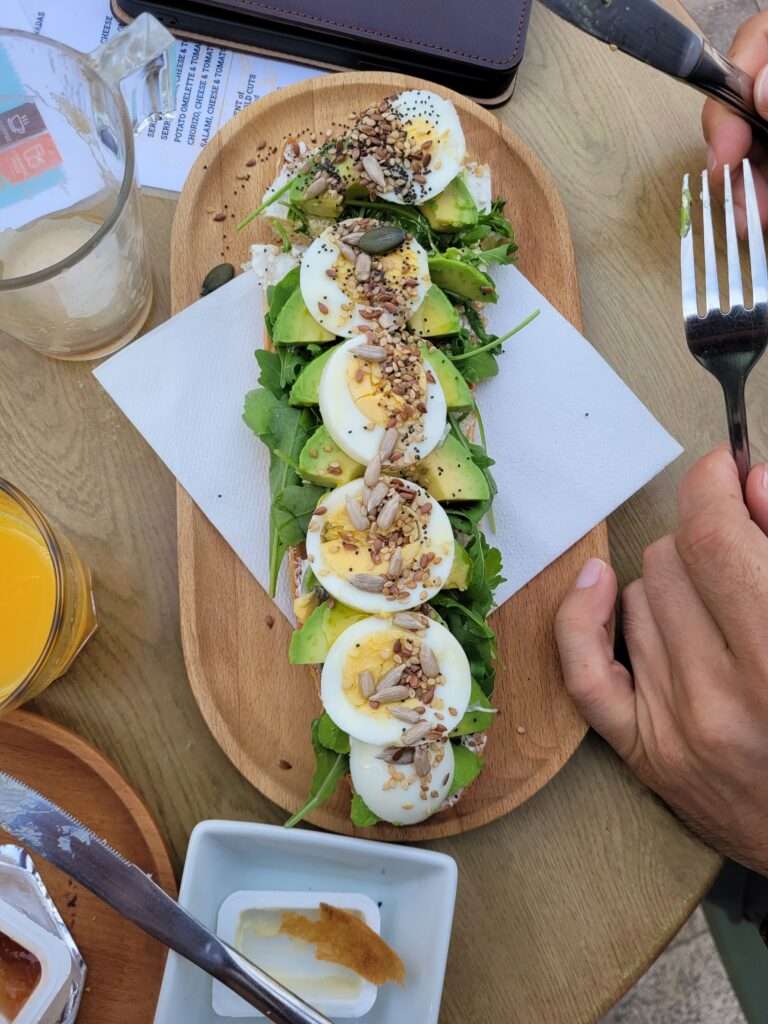
Suspect No. 2: Avocado toast at the neighborhood cafe, next to our AirBnB. Gary thought there was something funky with the egg.
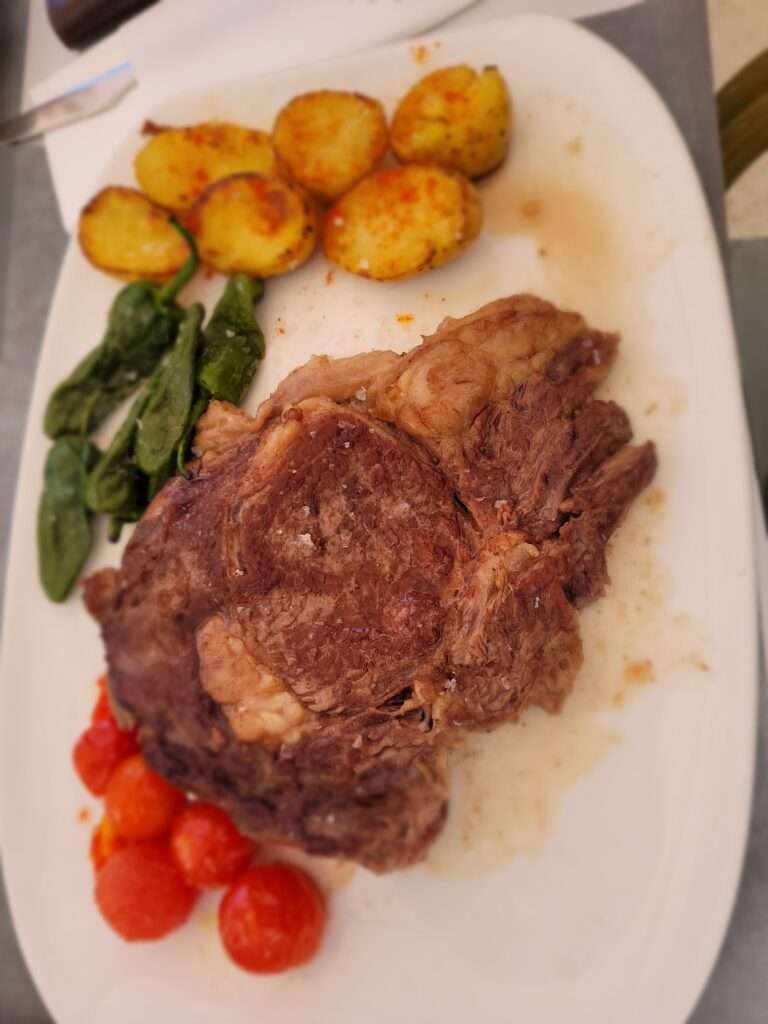
Suspect No. 3A: A steak at a beachside restaurant in Valencia. It turns out, the bacteria he got is from chicken, so this one gets a pass.
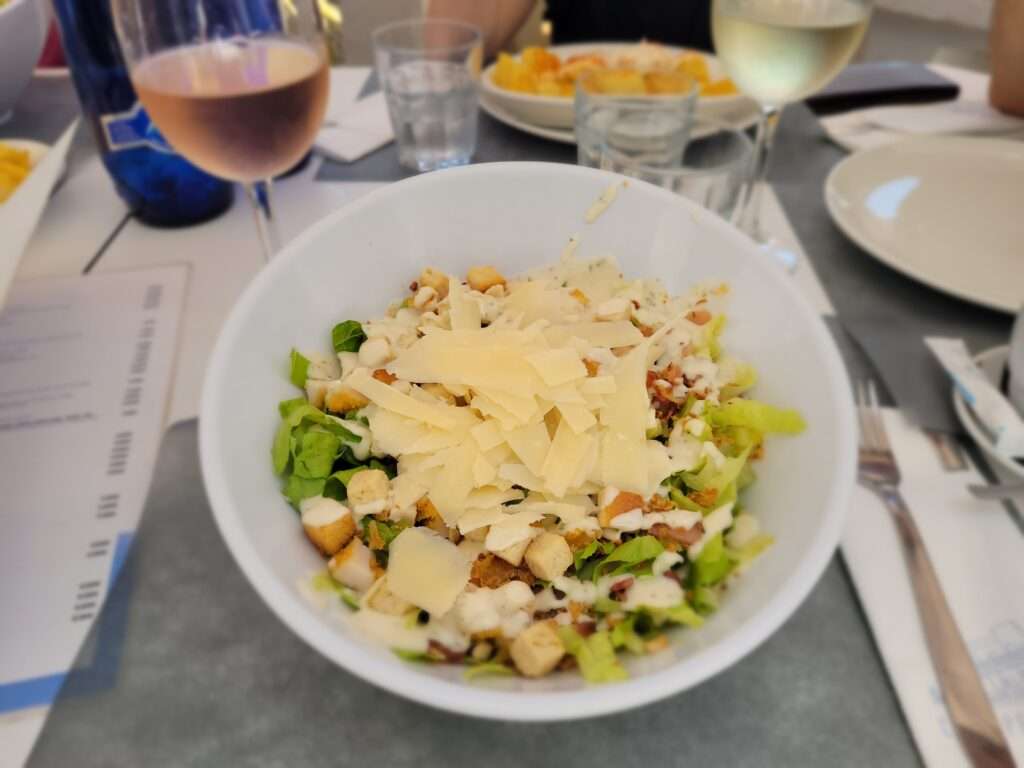
Suspect No. 3B: This was actually Ava’s salad, but she passed it down to Gary to finish. She usually passes over the meat, so he probably got all the chicken in the bowl. I also had one of these salads, but did not get sick like Gary. So we think this was probably not the culprit.
The moment the food poisoning set in
The day Gary fell ill, we had done a full day bike ride out to the beach in Valencia. Other than a couple of bike accidents (Sophia had a head-on collision with a grown man on an electric scooter), the day was relaxing and everyone had a great time. We had grabbed some spaghetti Carbonara and wine in the center. Ava said she needed to go to the bathroom and wanted to leave the meal early, and walk home. So Gary went with her. By the time I got back to the apartment a short while later, he was already sick. He said that he volunteered to walk home with Ava because for some reason he didn’t have any appetite. After Ava used the bathroom, it suddenly hit him hard and he had to spend time in the bathroom himself. He was suddenly very sick to his stomach.
La Farmacia! We need you.
The next morning, we traveled by train from Valencia to Toledo, Spain. It was a tough trip for Gary. He always needed to be near the bathroom, and he was visibly unwell. The second morning he was sick, Gary could not get out of bed in Toledo. He felt feverish and was very sick to his stomach. He was in the bathroom all the time. He didn’t have the energy to get food or medicine. So Sebastian and I went to the nearest pharmacy, as soon as it opened, to inquire about some medicine. The pharmacist didn’t speak English, so I made hand gestures to reenact all the symptoms Gary had. We received charcoal and hydration packs to add to one liter of water. I declined the Tylenol, as I already had some with me at the apartment.
By the next day, he was still sick and increasingly weak. He asked me to go back to the pharmacy and ask for Imodium. So I went to one where the pharmacist spoke English, and got him some. He took this and continued to hydrate. We also discovered Aquarius, a popular electrolyte drink in Spain, and he was drinking liters of this as well. He was able to venture out a little that evening and see Toledo and eat dinner. But as soon as he ate something, he was sick again.
Going to the doctor in Spain
The Immodium seemed to help a little bit. Gary was able to make it onwards to Zaragoza. The first evening in Zaragoza, he even ventured out to see the palace. However, by the next morning, he was again bedridden. He told me if he wasn’t better the next day (he had been sick 4 days at this point), he wanted to go to a doctor. He was still sick the next morning, unsure whether he even had the energy to make it to the doctor. I inquired with the apartment owner about where we could find a doctor and Gary mustered up the energy to walk the 8 minutes to the place she suggested we start at. However, the older man at the reception didn’t speak any English (and we no Spanish) and the only thing I understood is that we didn’t have the right document and the word “spital” which means hospital in German. So I told Gary we had to go to the hospital, not the clinic.
We stood outside trying to locate the nearest hospital on Google Maps. I told Gary, given his limited energy, I would go back inside and use Google Translate to locate the nearest hospital. When I went back inside, I noticed a woman in a white coat speaking to the younger female security guard. I wondered if these two younger women, might speak English. They did and the doctor showed me the closest hospital where we could be seen as foreigners, about 10 minutes in the opposite direction. So we walked to the hospital, hoping someone could help Gary.
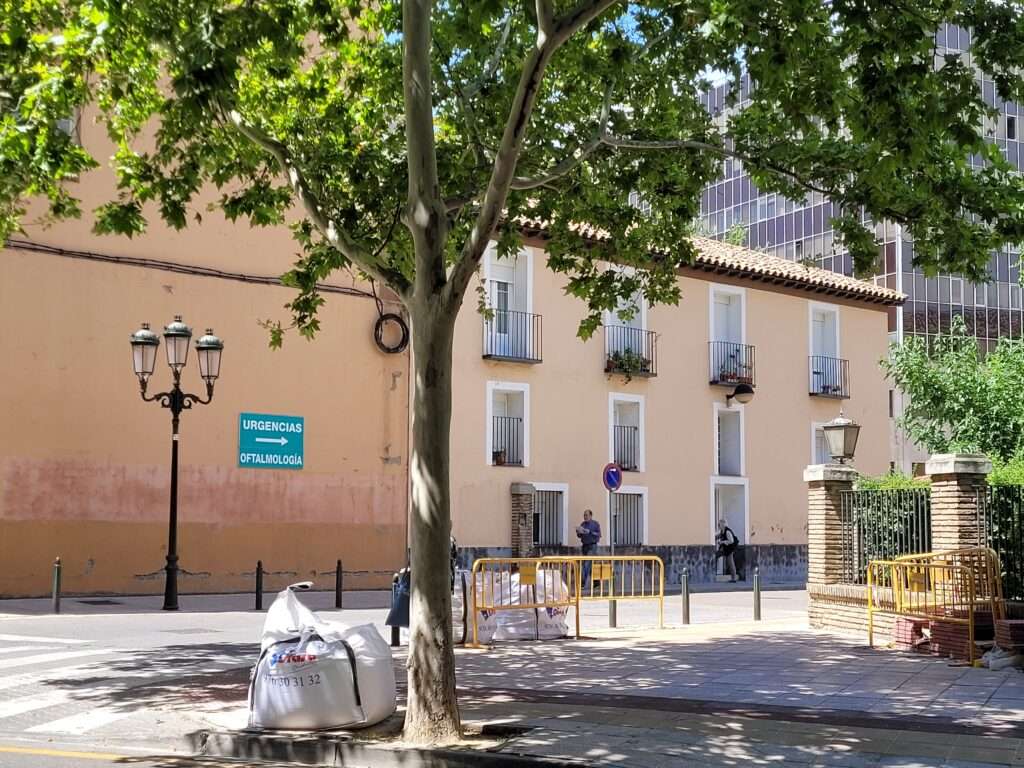
Photo above: We saw a sign pointing to Urgencia, and went that way. It was a large facility tucked away not too far from our apartment.
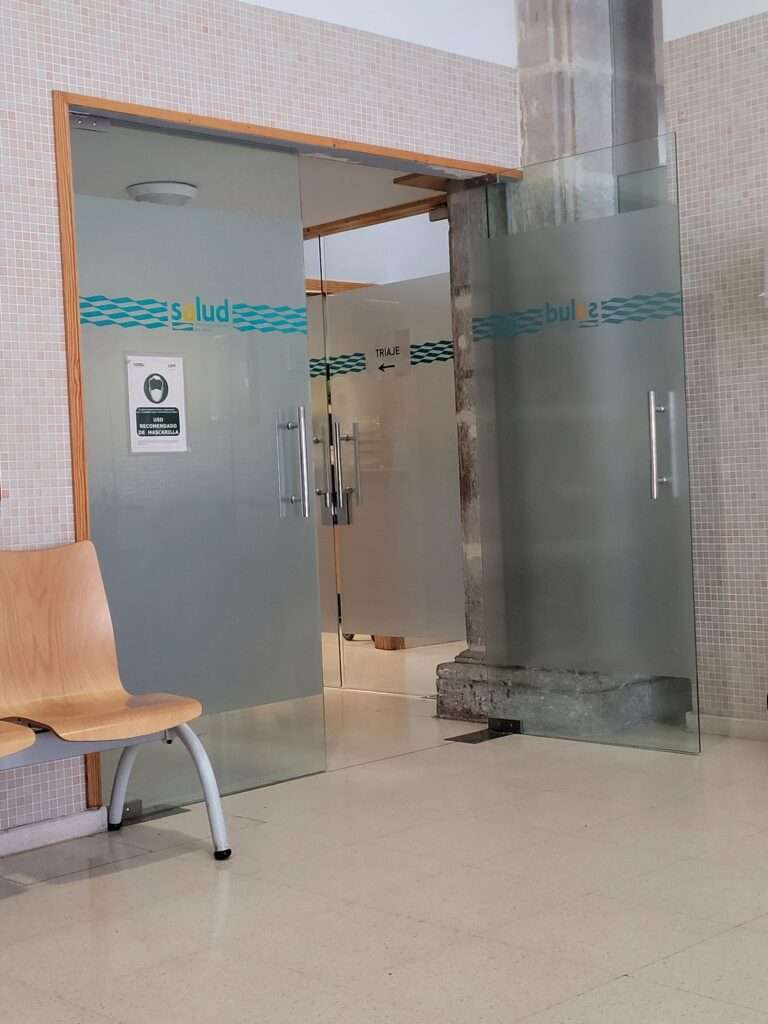
Photo above: The waiting room only had a few people in it. It was clean and open.
Our Spanish ER visit
The waiting room had a double door that led to a booth for registration. The man working at the counter said he didn’t speak English, but I understood he asked for Gary’s passport. We didn’t think to bring this, so I told Gary to provide his driver’s license instead. The man accepted the driver’s license, wrote some information from it (name/address) and handed it back. I used my hand gestures to explain Gary’s symptoms and the man returned gestures saying something in Spanish that I understood we should sit down and wait to be called.
We sat down and waited for the loudspeaker to blurt something that sounded like Gary’s name. We were soon called into Triage where they took his vitals and recorded his symptoms. One of the two people in the room spoke limited English, but enough to understand his symptoms and explain to use we needed to go back out to the lobby and wait to be called. I asked if the wait would be long, for example, could it be hours? I have heard stories of social medicine having long wait times, so I was worried. I was told as soon as a doctor was available we would be called. There was no estimate, but it could be hours or minutes.
About 15 minutes later, Gary was called over the loudspeaker, or so we thought correctly, and we headed back. We were taken into a doctor’s office, where two doctors sat at a computer, and we sat across the desk and spoke with them. They asked questions, we answered. They spoke good English and were patient with us. After discussion, one doctor took Gary to the exam table and checked some things, like pressing on his stomach. Then they explained that since we were leaving Zaragoza in two days, it was not enough time to get results from a food poisoning test. Additionally, the doctor said the process wasn’t fun and that he failed to think of another word, but that it involved testing “Sh!t.” He said that as long as Gary could keep liquids down, the recovery was the same regardless of type of food poisoning. He prescribed more of the hydration packets, which we were already using and told Gary to drink lots of Aquarius, which he was already doing. We were instructed to return if Gary vomited as then he might need IV hydration.
He was also told to stop eating for 8 hours and put on a strict diet, that would ease him back over time to a normal diet. These instructions were printed out for us, including a menu for the next 24 hours.
The calm before the storm
The next day, Gary felt a little better. He decided he could even go with us on a day trip to Loarre Castle. He was able to explore Zaragoza a little bit. He still felt somewhat sick and thought he had a low fever, but overall, he was feeling a bit better. We continued our travels to Tarragona, and he was able to keep up with our itinerary there. However, his leg was feeling a little odd. The next morning, we were leaving Tarragona to Barcelona airport to fly home. He woke up that morning and noted his leg felt really weird. He tried to get up but couldn’t stand. He realized his left leg was severely swollen and he couldn’t bend his knee or stand on the leg.
We were staying in a pedestrian only zone of Tarragona, and there were no taxis to be seen. I tried to call the taxi company but the woman dispatcher couldn’t understand me and eventually hung up on me and would not answer when I called back. So I hoped we could find a taxi enroute to the Tarragona bus station, where we had Plana bus tickets that would take up directly to Barcelona airport. But there was no such luck, and since we had to be at the station to catch the bus, Gary managed to will himself forward for the 20 minute walk.
About 5 minutes before the bus station, a taxi wizzed by and I was able to flag him down and put Gary and girls in it. Sebastian and I walked the rest of the way and met them there. We then rode on a bus to the airport, where Gary realized his leg was even worse now and there was no way to even hobble across the airport at this point. He barely made it off the bus.
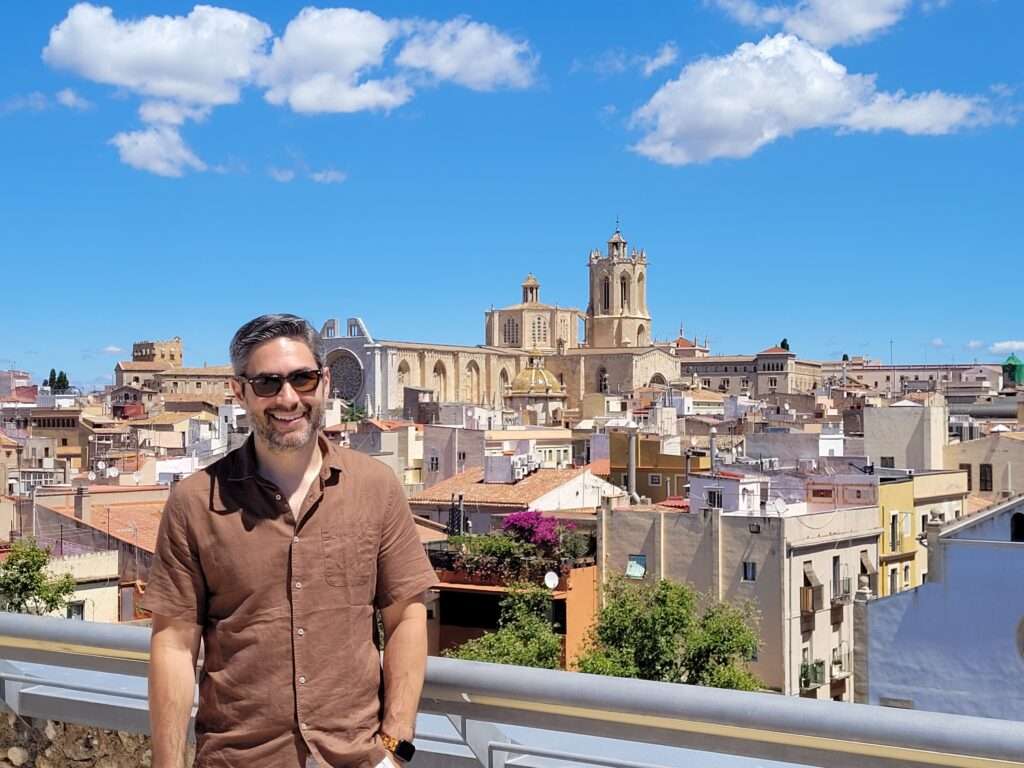
Photo above: Gary, the day before his leg suddenly swelled up and he could no longer walk.
Traveling with an injury
I had never traveled with a disability before, but I assumed there must be something the airline could do to help in this situation. I searched out the Air Canada desk, which I found was the farthest bay from where we entered. The line was ginormous and moving slowly. Fortunately, I had the Aeroplan Air Canada card and could use the priority lane. This made all the difference in this case; I don’t think I could have made it to the front of the line in the regular line to get help in time for the flight. The agent did require that Gary limp down to the line so she could see him, but then was able to offer him assistance. She had us take him to the wheelchair seating nearby and wait for someone to come on a cart to pick him up.
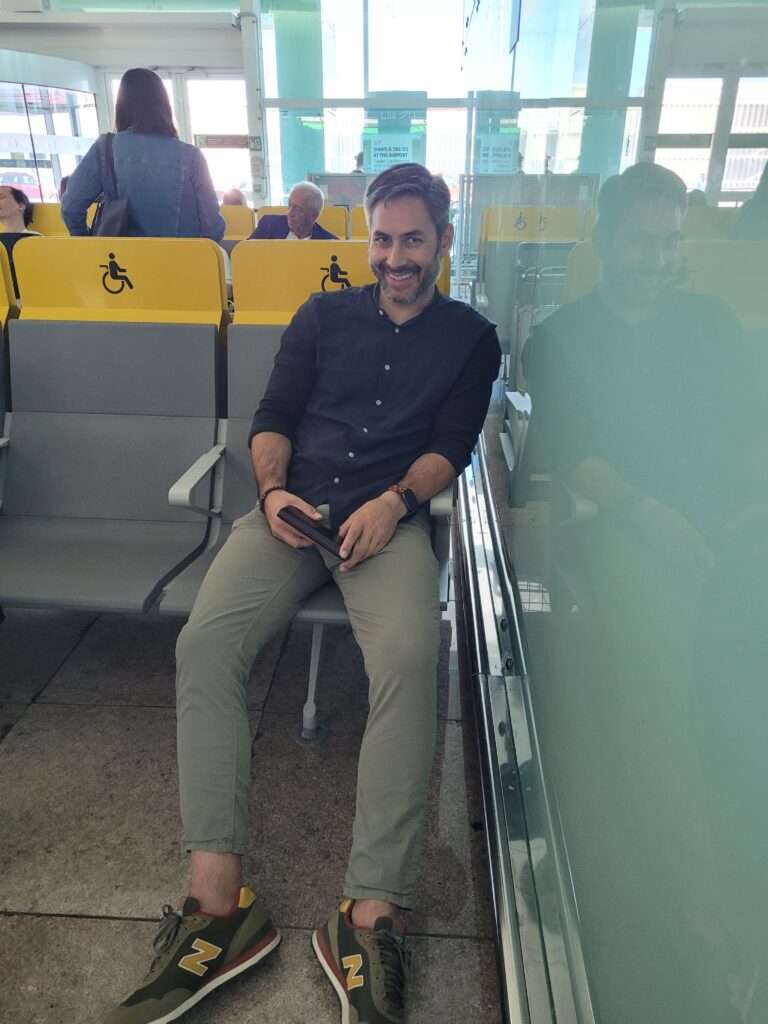
Photo above: You can’t tell by looking at him, but he was in lots of pain. I think he was a tad bit embarrassed so he flashed his million dollar smile to reassure us.
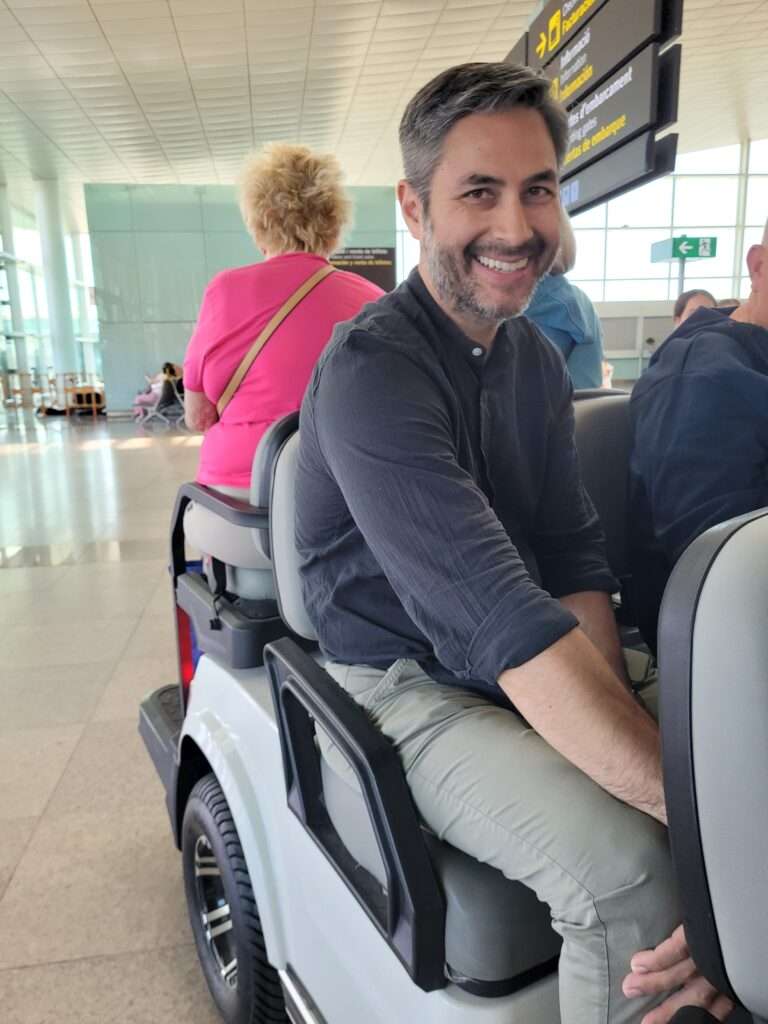
Photo above: Another smile for the camera. But Gary was so thankful for the lift; it was the only way he could get to the airplane.
What it's like getting through the Barcelona airport with disability assistance
The cart had a full load. Those traveling with passengers on the cart were initially instructed to walk behind the cart. We were swiftly fast-tracked through security in a special lane for the disabled cart. However, at customs, we were told we could no longer continue and would have to meet him at the gate. He said he was fast-tracked through immigration and customs, getting to the gate the fastest he has ever managed. We were able to join him at the gate at our own pace.
I already had priority boarding because of my Aeroplan card, but we were instructed to get in a special preboarding lane because Gary needed special assistance to get onto the plane. So we waited in the preboarding lane, while listening to other passengers who were cutting others in the priority lane, complaining about those in the preboarding lane not looking disabled enough, nor sitting in wheelchairs. One woman told her husband to bring his cane next time so they can qualify for special treatment. I was rather shocked by the things I heard from other passengers; I had never imagined others would make such unkind and inconsiderate judgments and loud statements about other passengers. The experience was humbling and mind-opening.
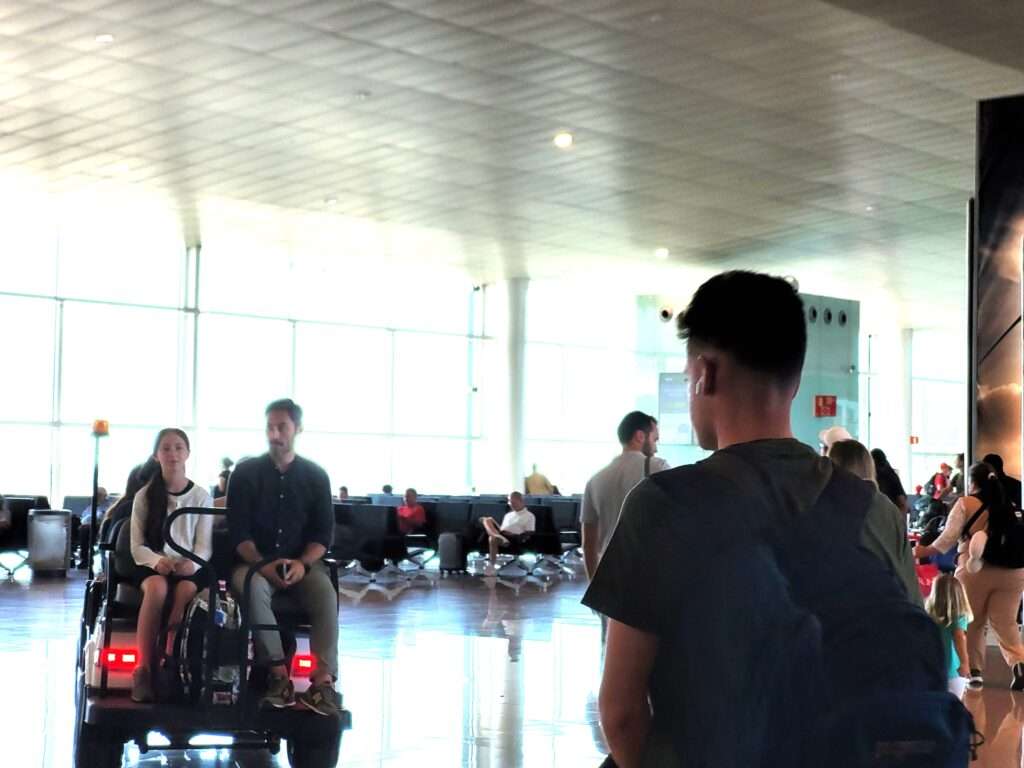
Photo above: Gary getting whisked away on the cart through Barcelona-El Prat. They had room at that point to allow Sophia to ride with him.
Having a medical problem on the airplane
Once onboard the plane, we were so relieved we had made it and would soon be home, where we could take Gary to the doctor. There had been no time that morning to take him as we had to catch the airplane, and the new symptoms were limited to his leg. I had read about reactive arthritis occurring a week after food poisoning and I assumed this might be what was going on.
Midway into the flight, Gary got up to go to the bathroom and fell in the aisle. He was at this point, unable to even make the short stretch. He returned to his seat and told me he didn’t think he could get off the plane in Montreal, and that his pain had intensified severely. He thought he was at a 8 out of 10, despite taking IBProfen, saying he thought an 8 was where the pain is so bad you are grimacing. I flagged down a flight attendant and explained the situation. She brought a big bag of ice to place on his knee.
She alerted the flight deck and they called ahead to have someone who could come onboard the aircraft and take him off. Our flight was coming in late and we weren’t sure if we would even make the connection. So we talked Plan B, about how to get him to the hospital in Montreal. However, with the special assistance, our whole group did make the connection, landing in Vancouver BC where we planned to stay overnight and drive home the next morning.
Dinner with a side of Campylobacter
We made it through the night, although Gary could no longer walk even short distances. Gary really wanted to try to make it home so he could go to a familiar medical facility, or at least in our country. He survived the 7 hour drive home and ordered crutches and a brace for his leg for pick up, so we could swing by Walmart as we drove into town, and pick it up. He was able to get into our house using crutches.
We tried to take him to urgent care, but it was Sunday and one was closed, and the other was too busy to accept any new patients. He decided at this point, he might as well wait until the next day, as the ER was always open, and if it got any worse between then, he could still go. The next day, we visited urgent care. He still had a fever. They were quite concerned about his leg and did blood work. He had a marker for a blood clot so had an ultrasound which ruled that out. They put him on Cipro, while they waited on results from 5 stool tests. When I dropped off the stool samples, the receptionist said it looked like a crappy start to the day.
It was probably about three weeks after he first got sick, that we finally got the results from the stool tests and it was confirmed he had Campylobacter. He was switched to the Zithromax (Z-pak), and within a day his fever finally went away, he started to feel better, and his leg started to improve.
A gift that kept giving
Gary has not been given any diagnosis for his leg/knee specifically; he saw an orthopedist specialist and did physical therapy. He was told there was nothing actually wrong with it; it was just inflamed and full of fluid. Just this past week, almost 6 weeks since he got sick, he woke up and his knee suddenly felt better. Just like it came on, it suddenly was gone.
I still think he had reactive arthritis as he met the criteria for diagnosis, but no doctor mentioned it. It continues to hurt off and on, especially when the weather turns cooler or it rains.
The Spanish ER bill has arrived
We were told that the hospital in Spain would be free, by our AirBnB owner. We were surprised at that idea. Medical care in the USA costs a fortune. However, about a month after we got home, we did receive a bill from Salud Hospital in Zaragoza, Spain. The bill for the ER visit was 131 Euro. We are still trying to figure out how to pay it as it is supposed to be paid by bank transfer. We tried to call and pay by phone but no one answered (likely due to the time zone). We will call again and hope we can pay by credit card over the phone.
An expensive souvenir no one wants
While the ER bill was a bargain compared to an American ER bill, the overall cost for this adventure has been high. Gary is still waiting to receive all the American bills from urgent care, the xray/ultrasound, the lab work, the orthopedist, the physical therapy, etc. If we add these bills to our vacation budget, this was our most expensive vacation ever!

